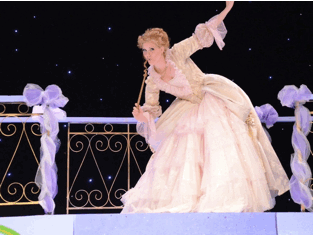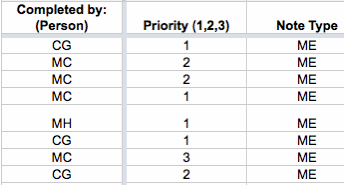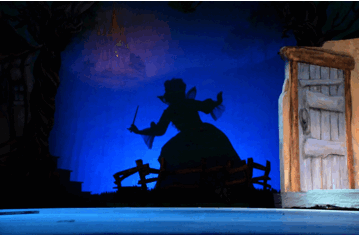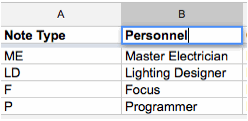The Utilization of Google Docs for Lighting Designers
by Christopher Gumpper, University of Minnesota-Duluth
During my time as the assistant lighting designer for a production of Cinderella I discovered the need for an easy means of communication between the lighting designer and lighting crew. The dissemination of information from the lighting designer and assistant lighting designer to the programmer, master electrician, and assistant master electrician would ideally be simple, accurate, and traceable.
of communication between the lighting designer and lighting crew. The dissemination of information from the lighting designer and assistant lighting designer to the programmer, master electrician, and assistant master electrician would ideally be simple, accurate, and traceable.
I utilized a Google Spreadsheet with a Master Notes section, which included the notes for every member of the lighting team. As the production began, the notes mostly included daily tasks both  added and checked off by the master electrician. Once we got to tech week, however, the lighting designer was making lots of notes for me to forward both the crew and the programmer, which needed
added and checked off by the master electrician. Once we got to tech week, however, the lighting designer was making lots of notes for me to forward both the crew and the programmer, which needed
to be completed by the next tech run. A code system was used which separated the notes as Programming (P),  Master Electrician (ME), and Focus Notes which needed to be completed by or in conjunction with the Lighting Designers.
Master Electrician (ME), and Focus Notes which needed to be completed by or in conjunction with the Lighting Designers.
Each note was placed on a separate line, which could be marked as completed by the appropriate supervisor typing their initials in the column labeled “completed by.” Allowing us to track who completed which notes. A separate sheet for was created for each of the Completed programming, ME, and LD. These sheets were protected  so that only I could move a note off of the master notes list. I protected the sheets so that I as the Assistant Lighting Designer had the opportunity to verify that each note was done correctly. This resulted in fewer missed notes and fewer duplicate notes from night to night. An added bonus of the Google spreadsheets was the ability for all parties to have access to the same information simultaneously. The information from each party can be viewed and updates in real time, which was particularly useful for the assistant master electrician who was watching the tech run while I was adding notes. If, for example I indicated there was a dead spot at area 54 in cue 12, he saw the note updated live and was able to and see during rehearsal exactly where the dead spot was that I was referring to.
so that only I could move a note off of the master notes list. I protected the sheets so that I as the Assistant Lighting Designer had the opportunity to verify that each note was done correctly. This resulted in fewer missed notes and fewer duplicate notes from night to night. An added bonus of the Google spreadsheets was the ability for all parties to have access to the same information simultaneously. The information from each party can be viewed and updates in real time, which was particularly useful for the assistant master electrician who was watching the tech run while I was adding notes. If, for example I indicated there was a dead spot at area 54 in cue 12, he saw the note updated live and was able to and see during rehearsal exactly where the dead spot was that I was referring to.
The most important job we have as collaborative artists is to communicate our ideas to the audience and to each other. In my experience it is the lack of communication on one or both of the counts that causes the most frustration within art. It is also the mastery of these that makes our art so rewarding. This is one tool that should be available in every designer’s toolbox to help maintain these lines of communication.
Photos by Kelly Lasley
